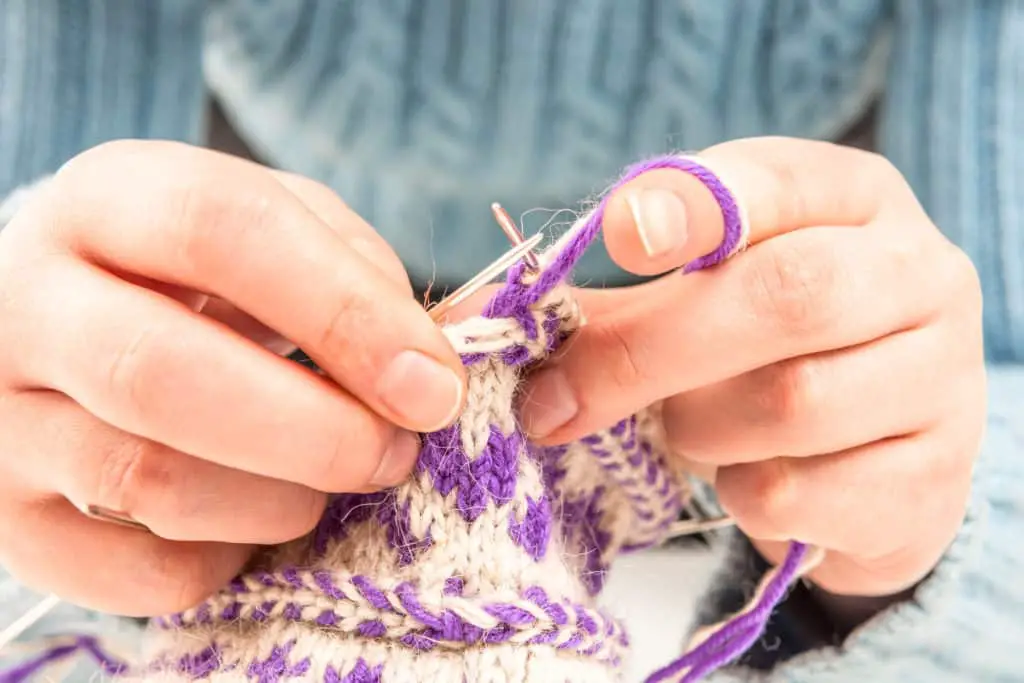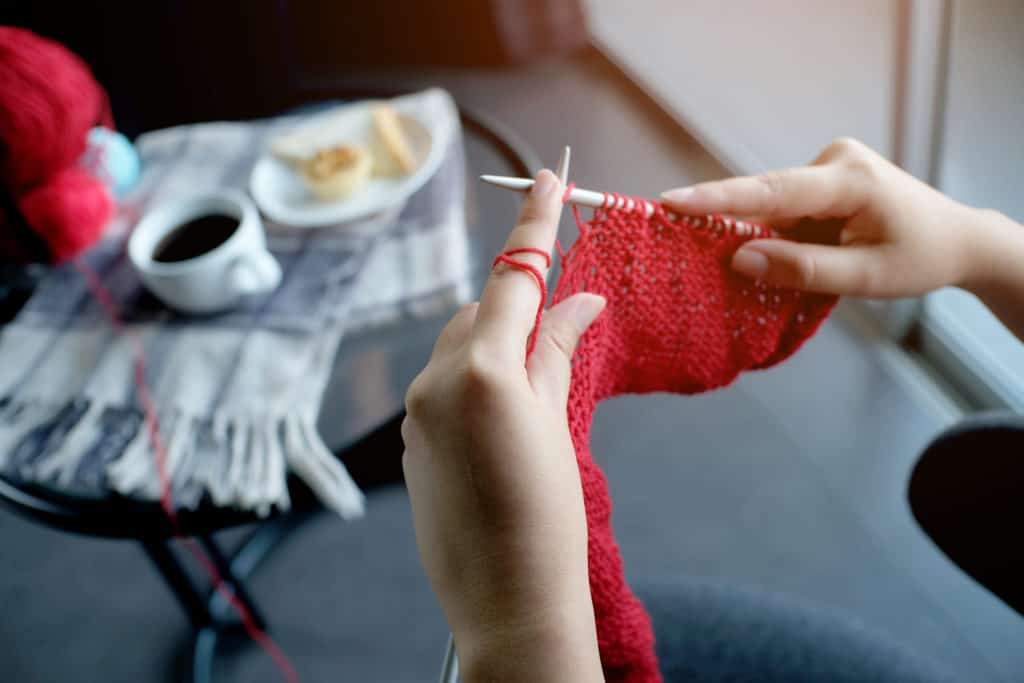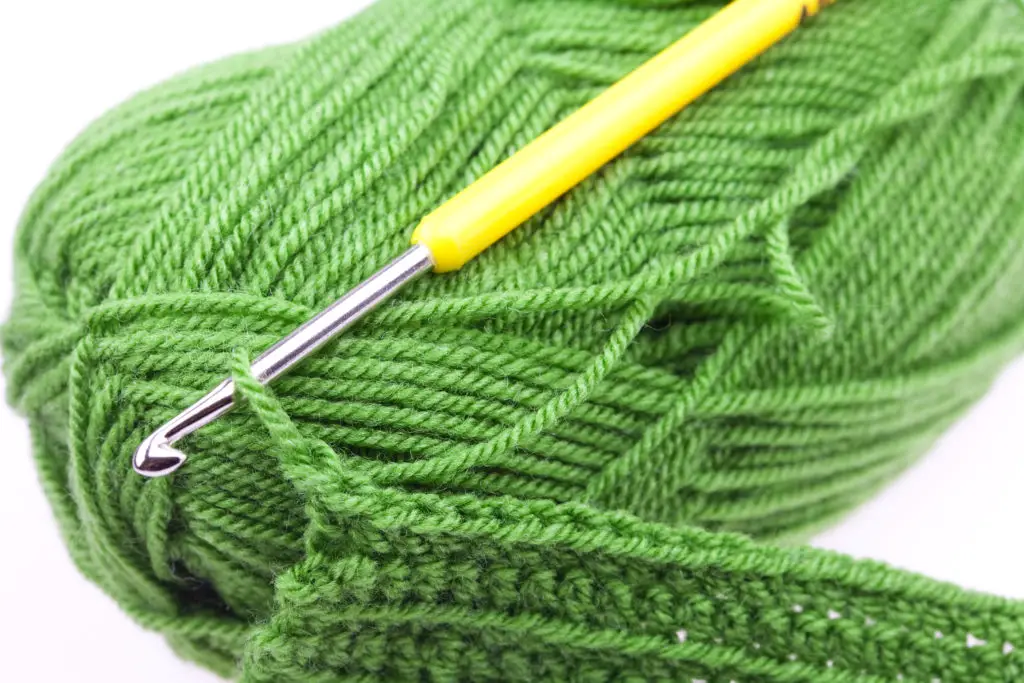A Complete Guide to Knitting and Crocheting
When people start out in yarn crafts, they often wonder what the difference is between knitting and crocheting. Although an experienced knitter or a master of crochet will be able to see the difference in the stitches, but to the untrained eye, the end result may look the same.
This guide will explore the differences, the similarities, and everything you might want to know about knitting and crocheting.

What Do Knitting and Crocheting Have in Common?
Before examining how these two arts are different, you need to understand what they have in common. Although they were different techniques used for different purposes many years ago, today, they share many similarities.
- You can use either method to make many projects, including blankets, scarves, hats, mittens, shawls, bags, totes, baskets, and more.
- Both knitting and crocheting involve stitching together yarn or fiber.
- Both use patterns and abbreviations, and some abbreviations are the same.
- Abbreviations are shortened codes for patterns in both crafts.
- Both knitting and crocheting are challenging, fun, and relaxing for people of all ages.
- Both crafts require similar skill sets, including the following:
- Hand-eye coordination
- Patience
- An eye for color
- Ability to plan a project
- Counting
- Both offer health benefits and are used in Occupational Therapy for the following benefits:
- Development of neuromuscular skills
- Development of fine motor skills
- Development of cognitive skills
- Self-expression
- Stress relief
Knitting and crocheting share many similarities, which is why people usually learn both. Once you have the basics down, it isn’t difficult to learn the different techniques that they each use.
Check out – Is Knitting Expensive? A Guide To Knitting Expenses
Supplies
One major difference between knitting and crocheting is the supplies you will use. Both crafts use yarn or fiber, but that’s where the similarities begin and end. Take a look at the supplies for each:
- Knitting: needles, looms, and machines
- Crocheting: crochet hooks, thread
Knitting uses two needles, which can come in a wide variety of sizes. Normally, each needle has a blunt side and a pointed side, and they can be wide, skinny, long, or short. This is one of the major differences between the two crafts. Crocheting uses one crochet hook. As with knitting needles, crochet hooks come in a variety of sizes, and they can be colorful as well.

In addition, knitting can make use of machines or looms, especially for making garments such as sweaters. Crocheting only uses the crochet hook, and it is always done by hand. People who knit may use a crochet hook to help them fix a mistake or to create a frayed edge on a blanket or scarf.
Finally, crocheting can use thread, whereas knitting cannot. Thread is too delicate for use in a knitting project, so you will want to use crocheting in a pattern that calls for thread. You can use a small thick crochet hook to handle the thread easily.
- Yarn
Both knitting and crocheting use many of the same types of yarn, although thread should not be used in knitting. Generally speaking, both crocheting and knitting will use equal amounts of yarn for their projects, so you will not save yarn by choosing one style over the other.
Stitching Methods
Another big difference is in the structure of the stitches. Both crafts use stitches that loop the yarn together, but they do it differently. Knitting uses two needles, and the yarn must be held on both needles for the entire project.
You will move the loops back and forth between the two needles. The loops hang down from the needle similar to a shower curtain. If you want to take a break from your project, it will be necessary to use needle stoppers, as you cannot remove the needles from your project. If you have more than one part to a project, you will need to use stitch holders to remove the needles for the other part of the project.
With crochet, you will use one crochet hook where you loop stitches onto the project. They are more similar to knots than stitches. If you want to take a break, you can remove the hook quite easily and leave a locking stitch marker so that you can pick it up later. It is easy to travel with your crochet project because you don’t need to worry about the hook falling out and unraveling the entire piece.

Common Mistakes
Each style has its own common mistakes, and the consequences vary. If you make a mistake and need to backtrack, the process is very different for each one.

With knitting, you will need to take out the stitches until you reach the mistake by transferring them in the opposite way. This can be difficult, and if you make a mistake in transferring the stitches back, it will create a bigger problem.
With crochet, it is pretty easy to fix a mistake. You can actually remove the crochet hook and pull the yarn, which will remove the loops until you reach the place where the mistake occurred.
In knitting, each stitch depends on the stitch below it, so if you miss one (also called dropping a stitch), you must fix it or the entire column below may fall out. Crocheting doesn’t have this problem.
People often wonder why these two crafts developed if they are so similar. The answer is in their history. When people began making garments and blankets many years ago, there were not nearly as many options for the fibers that they could use. Yarn choices were very different, and there weren’t many to choose from.
History of Knitting and Crocheting
As a result, knitting was used for making garments and items that required a better fit, whereas crocheting was used for blankets and scarves or table runners. Over the years, as more and more yarns have been developed and refined, both crafts are able to make just about any of the same projects. It really has become a matter of personal preference.
Which Is Easier to Learn?
It seems that everyone has a different opinion on this. Many people find that crocheting is easier to learn when you are starting out because crocheting only uses one hand, but there are people who think knitting is just as easy. It really is a matter of personal preference. If you try one and find it isn’t for you, try the other.
Once you learn one style, it is not difficult to learn the other, and many people do both. As you develop experience, you will also develop a preference for a particular style depending on your current project. The bottom line is that both are great tools to have, they are challenging, fun, and provide a wonderful mental break from everyday life.
Basic Knitting Stitches
People sometimes wonder how many types of knitting there are, and the answer is one. However, there are many different types of knitting stitches that are used. All knitting is rooted in two stitches, which are the knit stitch and the purl stitch.
All of the others are a variation of one of these. In a nutshell, here is the difference between the two:
- Knit Stitch: Create a loop in the back of your work
- Purl Stitch: Create a stitch in the front of your work
- Now look at this list of common knitting stitches (patterns):
- Garter Stitch: You knit across every row and finish with rows of ridges.
- Stockinette Stitch: Alternate rows of knit and purl stitches. It leaves V stitches on front and ridge rows on back.
- Reverse Stockinette Stitch: This is the reverse of the stockinette stitch, and it leaves V stitches on the back and ridge rows on the front.
- Rib Stitch: Alternate knit and purl stitches across a row to leave columns of each, which creates a ribbing.
- Seed Stitch: Alternate knits and purls across row, then reverse in the next row. This creates a textured pattern.
- Beginner Lace Stitch: Create patterns by wrapping yarn around the needle and knitting the two stitches together.
- Cable Stitch: Use knit and purl stitches, but you will twist a row of stitches to create the cable.
Fair Isle: Uses knits and purls, but you alternate colors to make color patterns.
Basic Crochet Stitch Patterns
As with knitting, crocheting takes a basic stitch pattern and builds on it for all kinds of variations. An important term to understand is “Yarn Over.” This term means that you grab yarn with your hook and pull it through a chain stitch. It is a part of most basic stitches.

Take a look at these basic beginner crochet stitch patterns:
- Crochet Chain Stitch: The most basic crochet stitch, it is often used to start a project. Make a slip knot on your hook, then pull the yarn through the slip knot loop. Repeat.
- Single Crochet: Put hook through center of next working chain, pull yarn through so there are two loops on the hook. Now draw yarn through both loops, which will leave you with a single loop again. Repeat.
- Double Crochet: Place your hook through next working chain, yarn over and draw up through chain stitch onto the hook, which leaves three loops on the hook. Yarn over and pull through two, leaving two loops on your hook. Yarn over again and pull through both, which leaves a single loop again. Repeat.
- Half Double Crochet: Yarn over and place your hook through center of next working chain. Yarn over and pull through so you have three loops on the hook. Now yarn over and pull through all three loops, which will leave just a single loop. Repeat.
- Triple (or Treble) Crochet: Yarn over two times, and put hook through next working chain. Now yarn over and draw up a loop so there will be four loops on the hook. Yarn over and pull through two loops, which leaves two loops. Yarn over again and pull through the final two loops, which leaves a single loop. Repeat.
- Tunisian Crochet: This is another style of crocheting more than a simple variation. Here are the steps:
- Make a slip knot.
- Begin your chain using an afghan hook.
- Go to the second chain from loop, yarn over and pull up loop. This is called a forward pass.
- Yarn over and pull through one loop, then yarn over and pull through two. This is a backward pass.
- After the backward pass, switch back to a forward pass.
- Repeat the forward and backward passes according to the directions in the pattern.
- End the project by making a modified slip stitch.
Knitting Tutorials
To learn the basics of knitting and the most basic knots, check out this video which goes into detail and should help you get started quickly.
There’s another video here which is also very popular and teaches an absolute beginner how to knit.
Crochet Tutorials
If you’re looking to learn how to crochet as an absolute beginner, check out this great detailed video here. This is a great step-by-step tutorial on how to crochet a chain, a single crochet, as well as many other techniques.
There’s another great beginner crochet tutorial video here that goes into detail but does it at a very slow rate so you can keep up.
Knitting and Crocheting Projects
- The reality is that you can make most projects using either method. Some experts prefer one method over the other, but it really is a matter of personal preference. When a project is completed, very few people can look at it and know which method you used.
- There are many patterns available online for either of these methods, and you really should start by choosing which one you want to try first. Many people begin with a baby blanket or a scarf. Try using a basic pattern with one color first, then branch out when you have the basics down.
- Try any of the following projects:
- Scarf
- Dishcloth
- Baby blanket
- Mittens
- Cup cozy
- Chemo cap
- Simple slippers
- Baby headband
- Simple tote
- Coaster
Once you get the hang of it, you will find that it is really not too difficult, and you can add in more challenging stitches, color changes, and patterns as you learn. Any of these projects make wonderful gifts, and they have a personal touch, too.
In Conclusion
The most important thing is to begin with a project that you can feel good about. Knitting and crocheting are fun, relaxing ways to spend time away from everyday life.
The repetition of the stitching relaxes your mind, while the project gives you a great way to unwind and make a home-crafted gift for family and friends. Start with the basics, and in no time, you will find yourself developing your own preferences for which is your favorite.
